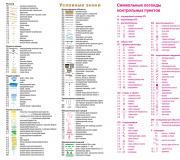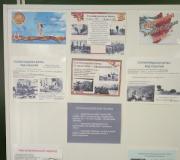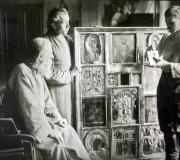The house is a museum of the history of the youth movement. Museum of the History of the Youth Movement, gbuk ro
A long time ago, at the end of the 19th century, a house was built in Ryazan for the next governor - a squat, two-story, spacious building with a cast-iron porch.
After the 1917 revolution, the first Ryazan Council of Workers', Soldiers' and Peasants' Deputies met in the former governor's residence. It was then that the building was nicknamed the “House of Freedom.” Later the street was renamed in his honor.
Two years later, when the Whites came close to the city, the headquarters of the Southern Front of the Red Army were located in the House of Freedom.
Then the house was transferred to the Komsomol Committee. Komsomol members, educating young people, organized a club named after Lunacharsky here.
In the 1930s, the building was converted into residential premises. But the memory of it as the House of Freedom was preserved among the people, and a corresponding memorial plaque hung on the facade.
In 1988, it was considered incorrect to use the historical building for housing. People were given separate apartments, and it was decided to make a Museum of the History of the Ryazan Komsomol Organization in the Freedom House. During the cleanup work, the building was renovated and an exhibition was placed in it.
Since the collapse of the USSR and the dissolution of the Komsomol, the authorities began to look askance at the museum. Having gotten rid of the word “Komsomol” in the name, it was renamed the “Museum of the History of the Youth Movement” (MIMD). They wanted to dilute the exhibition with exhibits of an anti-Soviet nature, but did not find a sufficient number of them. And, in the end, they diluted it with general information about the amateur creativity of young people.
In the “dashing” 90s, when “democrats” in power were replaced by “communists” and “patriots”, the museum received, accordingly, destructive directives, help, or simply indifference. The attempt at “global de-Sovietization” according to Fedotov-Karaganov under President D. Medvedev quickly came to naught and passed by the MIMD.
But now the de-Sovietizers have changed their tactics to more cautious ones. And they took seriously small provincial objects of the Soviet past. Their stated goal is to little by little erase all memory of the Soviet past from urban landscapes, and therefore from people’s consciousness.
And on December 18, 2015, from a news report on the “Culture” TV channel, MIMD employees unexpectedly learned about the organization, “as planned by Solzhenitsyn’s widow,” of a museum named after him in the House of Freedom. And, at the same time, about the transfer of MIMD - no one knows where... It must be said that almost six months have passed since Natalya Solzhenitsyn’s visit to Ryazan, and such a notification seemed as arbitrary as it was belated.
Being in complete bewilderment, employees of the MIMD turned for clarification to the Ministry of Culture and Tourism of the Ryazan Region, whose department includes the museum.
The response to this request was on December 27, 2015, when First Deputy Minister M.V. Gorozhanova summoned museum workers to her “carpet.” In very unkind terms, the deputy minister outlined the future fate of the MIMD: “they will give you a couple of rooms in Shchedrin’s house,” “you will transport the funds to Konstantinovo to the storeroom of the Yesenin Museum-Reserve.” The museum workers were made clear that the issue had already been resolved “at the top” and resistance was useless.
In fact, of course, the visit of Solzhenitsyn’s widow and the initiative of the writer’s local fans to make his museum in Ryazan are just an excuse. Otherwise, why not, leaving MIMD alone, not organize a Solzhenitsyn Museum in the house on Uritsky Street No. 17, where the writer lived and wrote “One Day in the Life of Ivan Denisovich”? Or at least in the same Shchedrin house, where Solzhenitsyn did not live, but which at least is related to literature? What is the appeal of moving museums apart from the double waste of funds?
It is absolutely clear that the main goal pursued by the regional authorities in line with the new policy of de-Sovietization is to remove the presence of everything Soviet from the center of Ryazan. And to do this, first of all, you need to remove the eyesore of the former Komsomol museum. Then, when renovating the building with budget money, you can adjust something - for example, remove the marble plaque with a reminder of the House of Freedom. And finally, set up an anti-Soviet propaganda and agitation point in this house with Solzhenitsyn’s name on the facade. So that the people of Ryazan forget about the “House of Freedom” and begin to remember the “House of Solzhenitsyn”. Well, then you can rename Svoboda Street, since there won’t be a house with that name on it. And then, you see, it will come to the street. Lenina, st. Lenin Komsomol and other Soviet titles.
However, despite the impudence of the local authorities, the public decided to oppose the transfer, and in fact, the actual liquidation of the museum and the transformation of the Freedom House into the anti-Soviet Solzhenitsyn House.
The Ryazan branch of the “Essence of Time” and the “Parental All-Russian Resistance” actively participated in the protest from the very beginning. The first thing we did was send an open letter to the governor demanding that he prevent the relocation of MIMD.
The text of the letter was initially signed by three organizations, including “The Essence of Time” and RVS, but then an obscure dark game began. So, the third structure that signed the letter unexpectedly asked us not to send it or, at least, to remove the signatures of its members. There was no direct mention of pressure on the signatories, but such a conclusion suggests itself, given that almost all members of the mentioned organization are civil servants.
After that, we went out to pickets to collect signatures from public organizations and ordinary citizens under our letter. Deputies from the Communist Party of the Russian Federation also made a request. The veterans sent their own letter of protest... The authorities were eventually forced to begin to react somehow.
On January 26, the Ministry of Culture and Tourism issued an official notice that the Solzhenitsyn Museum will occupy the building of the MIMD, and its collections will be transferred to the Saltykov-Shchedrin House and the Yesenin Museum in Konstantinov. However, as stated, the museum will continue to operate “in the same capacity”, and “staff will be retained”...
How can the museum continue to operate “in the same capacity” in Konstantinov, tens of kilometers from Ryazan? Where will the institutions that currently occupy premises in the “Shchedrin House” go? These questions remained unanswered... If we call a spade a spade, then with the above statement the museum workers simply threw a “bone”: agree to the conditions set - and no one will be fired.
The next day, at a meeting dedicated to the future anniversary of Solzhenitsyn, the vice-governor of the government of the Ryazan region, Sergei Filimonov, stated that the MIMD in the Saltykov-Shchedrin House would allegedly “be allocated an area no smaller than in the house in Svoboda.” And - he invited public organizations to “get involved in joint work and actively work on new exhibitions”... In other words, for the second time they decided to throw the bone not to museum employees, but to social activists.
It is characteristic that immediately after the “invitation” of social activists to work together, Filimonov went on vacation for three weeks. Well, we continued our work to inform the public.
On February 6, the governor finally announced that the eviction of MIMD was only “one of the options” and invited the public to discuss other options.
And on the same day, the Ryazan Vedomosti newspaper said that Solzhenitsyn’s widow was “upset” by the disputes over the location of the museum, which she learned about “from a letter from local social activists.” The widow said one accommodation option had already been rejected “due to prohibitive cost.” That the second one is supposedly “being discussed.” And that she is “ready to listen to both the third and fourth, but only after agreement is reached in Ryazan.” Thus, N. Solzhenitsyna wisely dissociated herself from the actions of local authorities.
In parallel with the struggle to preserve the MIMD and the House of Freedom, protest against the creation of a Solzhenitsyn museum as such in Ryazan is intensifying. For our part, we, “The Essence of Time” and the RVS, intend to firmly defend the thesis stated by Solzhenitsyn himself: “Do not live by lies!” All materials and exhibits of the future museum, if one takes place, will be carefully checked by us for historical accuracy. We will firmly insist on the availability of proper scientific explanations for artistic exaggerations and distortions of reality. It is not difficult to understand that a conscientiously constructed Solzhenitsyn museum cannot but expose the Nobel laureate himself. So does the city of Ryazan really need such a museum?
Today, the topic of destroying Soviet monuments is clearly artificially heating up among townspeople. Thus, on February 12, on the city portal, a certain self-proclaimed “initiative group” demanded to replace the monument to Lenin on the square of the same name with something “more patriotic.”
It must be said that once, in 1993, the “democratic” authorities already demolished the monument. (The main “democrat” who demolished the monument is now serving time for extortion in places not so distant.) Lenin was then replaced with a postmodern configuration of three figures, designed to resemble the domes of the Assumption Cathedral of the Ryazan Kremlin, but, alas, did not resemble them. The clumsily and incompetently made structure was popularly nicknamed “three boobs.” The matter ended with the new communist governor Lyubimov removing this shame from the city square and restoring the monument to Lenin in its original place.
Since then, no one in the city has had any fun with the demolition of monuments... And now the de-Sovietizers, it seems, have decided to get back to their old ways, in solidarity with what is happening in Ukraine.
On February 15, we again took to the governor’s reception an appeal in defense of the museum, already signed by 16 public organizations and 350 residents of Ryazan. Copies of the letters and signatures were sent to the head of the Administration of the President of the Russian Federation S. B. Ivanov, who is the chairman of the organizing committee for preparing for the celebration of Solzhenitsyn’s anniversary. Our message, among other things, contains a reminder of upcoming anniversaries: the 100th anniversary of the October Revolution and the 100th anniversary of the Komsomol. Is the government going to celebrate these anniversaries?
So far, we have received from the authorities only another formal reply signed by the Deputy Chairman of the Government of the Ryazan Region E. I. Bunyashina. The unsubscribe notifies that the museum will remain “in the same status and with the same employees, while maintaining its thematic focus”.
We continue collecting signatures for an appeal to the governor. Most of the Ryazan residents we met on the street while collecting signatures in defense of the Museum of the History of the Youth Movement spoke very expressively about both the authorities and Solzhenitsyn’s fans. One of them signed as “October and pioneer, Komsomol member and communist, officer of the Soviet and Russian army, reserve major” and added verbally: “Tell them that they are going to cross out my whole life!” There are many signatures and young people who are not going to give up the history of their city and family.
Public hearings are coming, at which biased officials, apparently, will try to implement the decisions they need...
On March 19, a rally will be held in defense of the Museum of the History of the Youth Movement, to which we invite all concerned citizens.
We repeat once again and repeat as many times as necessary: the public is interested, first of all, not in what subordination and on whose balance sheet the museum will be, partly moved and partly preserved. We asked and continue to ask the main question: why is the Museum of the History of the Youth Movement being moved at all? Who needed to touch him? What will be the fate of the building of the first Ryazan Council, the House of Freedom? And, finally, how long will local authorities ignore the opinions of residents and forcibly destroy monuments of our culture and history, under the beautiful words about “living not by lies”?
Our demand remains unchanged: leave the Museum of the History of the Youth Movement in the building where it is now located!
Number of storage units: 19262 storage units (fixed assets).
Presented types of collections:
Written sources (documents, printed graphics, printed materials)
Material sources (fabrics, numismatics, wood, leather, glass, porcelain, ceramics, metal, plastic)
Fine arts (painting, graphics, sculpture)
The museum continues to form a fund on the history of the Great Patriotic War, a separate collection of heroes of the Second World War and local wars is being collected, and a collection is being formed on the history of the modern youth movement.
|
||||
|
The Youth Museum program is focused on the targeted involvement of students in the study of museum studies and represents a theoretical and practical addition to the course “Museum Studies” as part of the additional education of students at the S.A. Russian State University. Yesenina. The program was developed in accordance with the main educational programs of higher educational institutions, together with the department of educational technologies. |
||||
|
The Youth Museum program is focused on the targeted involvement of children and students in the study of the history of the Afghan War (1979-1989), is an addition to the course on the history of Russia and is developed in accordance with the curriculum and taking into account age characteristics. This program will help teachers and lecturers in preparing and conducting history lessons, lessons of courage, lectures, conversations, various public events, classes, class hours, and will make school classes more meaningful and rich in new facts. The program provides for the combination of general historical and local history material on the history of the Afghan War (1979-1989) The Youth Museum program is focused on purposefully introducing children and students to the study of the history of the Great Patriotic War, is an addition to the course on the history of Russia and is developed in accordance with the curriculum and taking into account age characteristics. This program will help teachers and lecturers in preparing and conducting history lessons, lessons of courage, lectures, conversations, various public events, classes, class hours, and will make school classes more meaningful and rich in new facts. The program provides for the combination of general historical and local history material reflecting the life of Ryazan and Ryazan residents during the Great Patriotic War. Museum interactive program “Pioneer Country” |
The Youth Museum program is focused on purposefully introducing children to the pioneer organization. It is a game with a symbolic admission to pioneers, and a visit to various “stations” (“historical”, “medical”, “tourist”, “game”, “music”, “film station”), where children get to know the people of Ryazan in a playful way Heroes of the Soviet Union; learn to provide first aid; gain camping skills and rules of behavior in nature; get acquainted with pioneer games and bugle calls, as well as Soviet cinema for children. This program will help teachers and lecturers in preparing and conducting various public events , classes, class hours.The program provides for a combination of general historical and local history material.
Museum program with disabled children “Tell the exhibit about yourself”
The Youth Museum program is focused on purposefully introducing children to museum exhibits. It represents an individual acquaintance of a child with an exhibit of his own choosing, studying it, memorizing a fragment of the excursion text related to this subject, and with the further performance of a group of children in the role of guides, telling their classmates about the selected museum objects. This program helps children get comfortable in the sociocultural space, stimulates the development of memory and speech of a disabled child, helps remove the barrier to speaking to an audience (class) and communicating with unfamiliar people, and develops the child’s social activity. This program will help teachers, lecturers and speech therapists in the social rehabilitation of children who need correction of language development and other characteristics of this category.
Exhibition plan for 2015:
— photo exhibition “Everything”
— photo exhibition in memory of E. Kashirin
- exhibition from the funds of the MIMD “Sailors of Ryazan in the cities. WWII"
— environmental exhibition (photo)
September
— an exhibition of decorative and applied arts dedicated to the 920th anniversary of Ryazan (ceramics, folk costume, jewelry)
— “History of the Pioneer Movement”
— personal exhibition of R. Lysenina (sculpture)
— exhibition of youth design “Search Geometry”
— “Great Expectations” Efim Ershov (collages, animation)
— 10th anniversary of the Our Heritage Foundation
— “Great Expectations” by San Shalandin (photo)
— exhibition “World of Travel” as part of the project “It’s time to hit the road, old man”
Activity:
Day of military glory of Russia. Celebration of Navy Day (meeting with fleet veterans)
— an event dedicated to Cinema Day “Screen adaptation of Russian classics”, as part of the Year of Literature in Russia
September
— an event dedicated to the Day of Knowledge “no one is forgotten, nothing is forgotten”, as part of the celebration of the 70th anniversary of the Victory
— event dedicated to the Day of Solidarity in the Fight against Terrorism
— an event dedicated to the Day of Remembrance of the Victims of Fascism, as part of the celebration of the 70th anniversary of the Victory
— Day of the Elderly (free excursions, concert)
— grand opening of Raisa Lysenina’s personal exhibition dedicated to the artist’s 60th anniversary
— “Festival of White Cranes” in memory of those who fell on the battlefields, as part of the celebration of the 70th anniversary of the Victory (meeting with Ryazan poets, concert)
— all-Russian event “Night of the Arts” (master classes: painting, photography, design)
— youth dialogue dedicated to National Unity Day in Russia
— youth dialogue dedicated to Hero’s Day “Heroes of the Soviet Union - Veterans of the Great Patriotic War”
— an event dedicated to the beginning of the war in Afghanistan (meeting of students with veteran internationalist warriors)
— an event dedicated to the celebration of the New Year “The Museum gathers friends and sums up the year”
— a gala event dedicated to the anniversary of the “Our Heritage” foundation (in memory of Ryazan artists, poets and musicians)







Museum of the History of the Youth Movement (Ryazan, Russia) - exhibitions, opening hours, address, phone numbers, official website.
- Tours for the New Year in Russia
- Last minute tours in Russia
20 thousand exhibits of the Museum of the History of the Youth Movement tell about its role during the revolution, exploits on the battlefields of the Great Patriotic War, selfless work on great construction projects and participation in the Afghan and Chechen conflicts. It is located in a modest one-story house, which once served as the residence of the vice-governor, and under Soviet power became the revolutionary committee, and then the city committee of the Komsomol.
Under the same roof as the exhibition halls is the Chapel of St. George the Victorious, dedicated to the memory of those who fell in the wars of the last century.
The museum has several permanent exhibitions. In the “Letters from the Front” hall, visitors get acquainted with the fates of Ryazan residents who participated in the defense of Moscow, the battle of Stalingrad, and the capture of Berlin. The story of their heroism continues in the “Hall of Valor and Glory,” dedicated to the Heroes of the Soviet Union and holders of all three degrees of the Soldier’s Order of Glory. Documents and photographs on the stands in the “History of Modern Wars” hall tell about local conflicts where young Ryazan residents took part. Unexpectedly, many natives of land-based Ryazan were among the sailors. At different historical moments, they accomplished many heroic deeds, which are described in the exhibits of the special hall “The Glory of the Fleet to Increase...”
Practical information
Address: Ryazan, st. Svobody, 79. Website.
How to get there: by buses No. 4, 16, 20; trolleybuses No. 2, 16; minibuses No. 87 - to the stop. “Michurin Square”, then walk along the street. Mayakovsky, turn onto st. Freedom and follow it to the museum for about 5 minutes.
Opening hours: Monday to Wednesday, Friday and Saturday from 10:00 to 18:00, Thursday from 13:00 to 21:00. Day off is Sunday.
Ticket price for adults - 80 RUB, pensioners - 60 RUB, students and schoolchildren - 50 RUB. Admission is free for visitors with disabilities. Prices on the page are as of November 2018.




